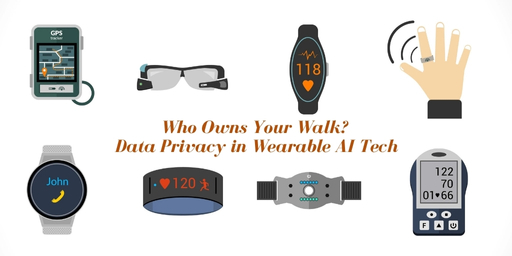You will notice that whenever a smartwatch tracks your steps, monitors your heart rate, or notes your sleep cycle, it is recording a part of your life story or better to say your life walk and the bitter truth is that you're not the only owner of that data.
The Illusion of Control
Many users believe that they are the ones who control the data of their wearable items. Obviously, it’s their body, their health, their device—right? Not much. When you agree to all the terms and conditions, you permit the company to access, store, and even sell your data in anonymised or aggregated forms. In certain cases the anonymised data can be re-identified with much cross-referencing. In simple terms, your digital footprints are more easily accessible than you think.
A Patchwork of Privacy Laws
The rights over wearable data may vary on the basis of geographical location. Some regions have strong data protection laws that allow the users the right to access, delete, or limit the use of their data. Others have minimal safeguards leaving the users with minimal safety. There are wearable companies that operate globally, navigating a patchwork of inconsistent laws. Therefore, the level of data protection users receive majorly depends on geographical region rather than ethics.
AI Behind the Scenes
AI is deeply rooted in wearable tech. It analyses more than just your steps such as movement patterns, predicting potential threats, etc. Some devices even use on-device AI to keep data local, enhancing privacy. But many rely on cloud based systems, here the raw data is kept, and processed—sometimes indefinitely. This gives rise to critical questions: Who all can access the data? How long is it kept? How is it being used?
The Hidden Risks
The hazards of sharing your wearable data goes beyond those annoying ads. There is a high risk of cross-device tracking, where multiple sources of data are connected together to build a detailed profile of your habits. There’s also the potential for health-based discrimination, where insurers or employers might penalise individuals based on their activity levels or sleep patterns. And then there are more technical threats—like re-identification attacks—that can compromise even “secure” data.
The Trust Deficit
The users are now questioning the wearable tech companies over data security. Many users don't have the slightest idea about how their data is being used and without transparency trust fades. If users suspect their data is being mishandled, they may abandon the technology altogether. This isn’t just privacy which is at stake but business too. The future of wearable tech relies on trust.
How to Reclaim Control
There are many ways through which users can protect their data without giving up wearable tech. Firstly, they need to review privacy settings and disable unnecessary tracking. Secondly, opt out of third-party data sharing, choose brands that prioritize on-device AI and encryption, use your legal rights to access or delete data, and be selective about which apps you sync with.
The Road Ahead
Wearable techs are fastly evolving. Future innovations might include decentralized data systems, blockchain-based consent management, and stronger default data protection settings. Industry leaders are also working toward standards that make privacy the norm, not the exception.
But change doesn’t happen automatically. It requires demand—from consumers, regulators, and ethical tech companies. As users, we need to push for transparency, accountability, and the right to control our own data.
Your walk, your heartbeat, your habits—they’re more than just numbers. They represent your life. And in the digital age, owning that data means owning your identity. The question isn’t just "Who owns your awalk?"—it’s "Are you ready to take it back?"

